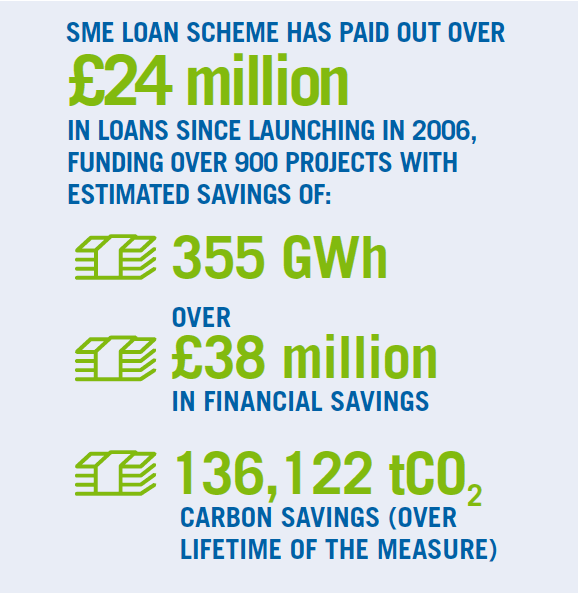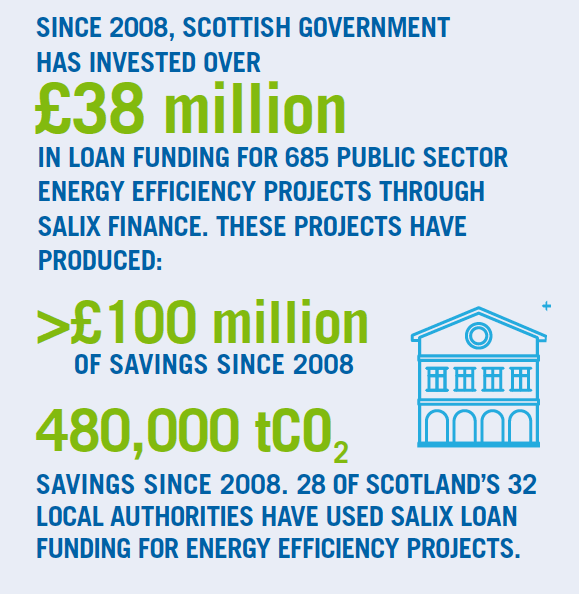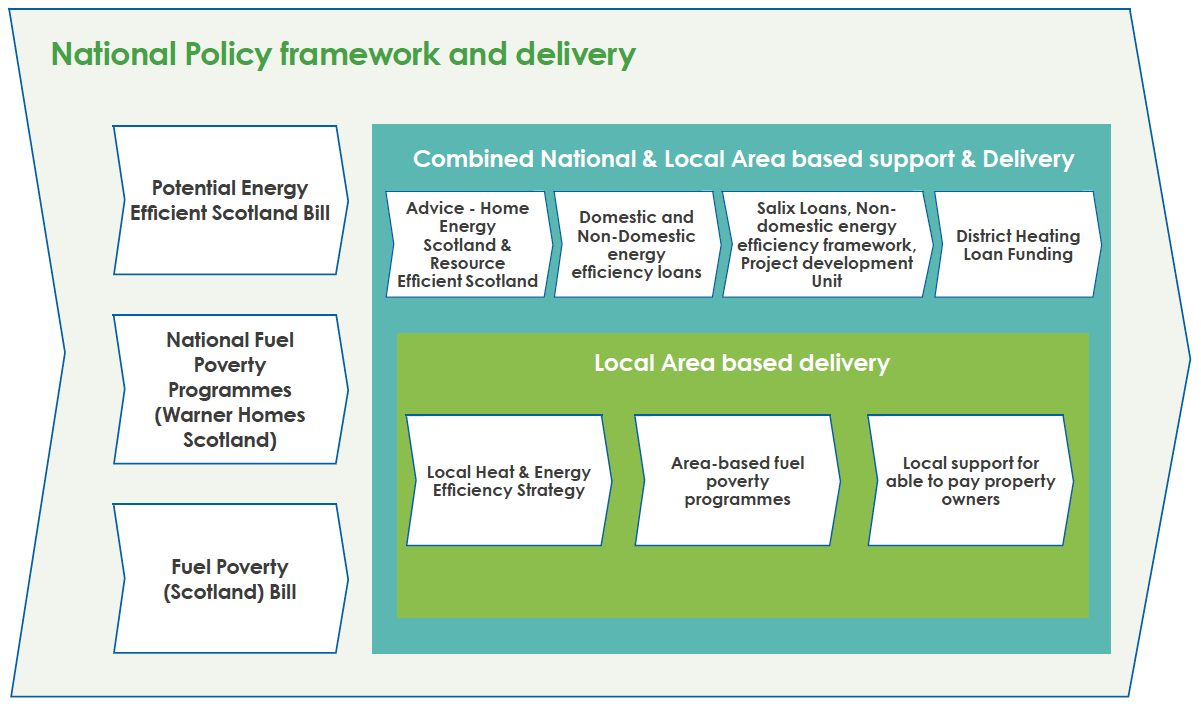Energy Efficient Scotland: route map
This route map for the Energy Efficient Scotland programme sets out the journey our homes, businesses and public buildings will take to become more energy efficient.
Chapter 4: Delivering on the Ground
Delivery Programme And Delivery Mechanism
Overview
The Scottish Government has a long track record of supporting improvements to domestic and non-domestic properties.
Domestic Energy Efficiency 2013-2016
Infographic:

Infographic Text:
Total HEEPS Investment of £248m > Overall investment in domestic energy efficiency in Scotland £618m > 96,000 households assisted by HEEPS since 2013 > 2.42m tonnes of CO2 saved by our HEEPS programmes > £542m savings in household fuel bills by HEEPS
Infographic:


Infographic Text:
SME Loan Scheme Has Paid Out Over
£24 Million
In Loans Since Launching In 2006,
Funding Over 900 Projects With
Estimated Savings Of:
355 GWh
over
£38 Million
In Financial Savings
136,122 tCo 2
Carbon Savings (Over
Lifetime Of The Measure)
Since 2008, Scottish Government
Has Invested Over
£38 Million
In Loan Funding For 685 Public Sector Energy Efficiency Projects Through Salix Finance. These Projects Have Produced:
>£100 Million
Of Savings Since 2008
480,000 tCo 2
Savings Since 2008. 28 Of Scotland’s 32 Local Authorities Have Used Salix Loan Funding For Energy Efficiency Projects.
Transition Phase
We have outlined the offer of support currently in place and the next steps we will be taking in each sector earlier in the Route Map. Our energy efficiency programmes have developed over time to deliver different objectives across domestic and non-domestic properties. Through Energy Efficient Scotland we have begun a process of moving to a more integrated approach so that households, public bodies and businesses can more easily plan and deliver energy efficiency improvements. We are now launching a Transition Programme that will take us through to full rollout.
Transition Programme
The Transition Programme is in addition to the national framework of advice, support and regulation that we are proposing in this Route Map. It builds on our existing programmes, earlier pilots, and supports the continuing development of LHEES. The two year Transition Programme, beginning in May 2018, will gradually give local authorities the opportunity to plan and deliver integrated energy efficiency projects. This will be based on their current activity on domestic Area Based Schemes to tackle fuel poverty but expanded to cover able-to-pay households, retail, commercial and industrial properties and joining up with their current projects on the public sector estate.
Alongside the Transition Programme and the support delivered by local authorities, we will be maintaining our national provision, with our existing national fuel poverty programmes and existing loan programmes continuing to be available to support households or businesses that are based outside designated area based schemes, and to bodies in the public or private sector which are developing heat networks.
Year 1
- continued funding for domestic fuel poverty programmes (currently HEEPS: ABS)
- funding support to allow local authorities to move into domestic and non-domestic able-to-pay market
- continued funding to support LHEES development
- continued funding to provide national advice, support and information via HES and RES
- continued funding to provide loans to individuals, SMEs and public sector for energy efficiency improvements
- continued funding and support for public sector projects through SALIX loan funding, the Non- Domestic Energy Efficiency Framework and Project Development Unit.
Year 2
- continued funding for domestic fuel poverty programmes (currently HEEPS: ABS)
- funding support to allow local authorities to move into domestic and non-domestic able-to-pay market
- continued funding to support LHEES development
- continued funding to provide national advice, support and information via HES and RES
- continued funding to provide loans to individuals, SMEs and public sector for energy efficiency improvements
- further supporting energy efficiency in the public sector by incentivising integration of domestic, non-domestic and public sector projects through SALIX loans and continuation of the Non-Domestic Energy Efficiency Framework and Project Development Unit.
Delivering in partnership with local government
Energy Efficient Scotland will be a strategic partnership with local government. Throughout its development, we have consulted and discussed the design with our partners in COSLA, so that we can jointly build upon the successful components of existing programmes. From the start, in our initial pre-consultation discussions with stakeholders, they identified the importance of strategic planning for Energy Efficient Scotland at local and national levels across the 20 years of the programme.
Given the need for this strategic planning to take place from the outset of the programme, we have already consulted in detail on proposals for LHEES. LHEES would be the foundation on which the Programme is delivered at a local level over the lifetime of the Programme. Its purpose is to:
- Provide the evidence base to guide the Programme, locally and nationally over its 20 years. Each local authority would assess its building stock, identifying the potential for improvement in energy performance and heat supply in order to meet long term the Programme standards. The LHEES would support setting objectives to deliver this improvement, and the scale of the investment needed to meet it. Looking at all of the LHEES together across Scotland would give a comprehensive picture of the building stock and levels of improvement needed for the whole of the Programme.
- Act as the guiding framework for developing and funding future investment strategies. The analysis that each local authority undertakes in preparing its LHEES would help it to prioritise and cost local delivery programmes. These would be submitted to the Scottish Government for approval and funding. The LHEES analysis would also help the Scottish Government to design and support national investment programmes (where needed) that could complement local authority activities.
- Provide an investment prospectus for developers and the supply chain in the energy efficiency and heat sectors. The data underpinning each LHEES, and the objectives that it sets, would provide valuable market information for investors (from both the private and public sectors) on potential new investment opportunities. The prioritisation and costing of local Energy Efficient Scotland delivery programmes and national investment programmes would help to give investors and the supply chain certainty to help them plan for long term delivery across the 20 years of the programme.
Given that LHEES would be central to informing and shaping the overall delivery of the Programme, we are proposing that there should be a statutory duty on local authorities to prepare and deliver them. We recognise that there are resource implications for this and that additional support may be required.
We have therefore consulted twice during 2017 and 2018 on the purpose, scope, and content of LHEES, and on the powers and resources needed to deliver them. In parallel, we have been working with COSLA and 12 local authorities to pilot the preparation of LHEES. This is allowing us to understand the processes of data gathering, objective setting, and design and prioritisation of local delivery programmes. The pilots are testing different methodologies and providing evidence on the resources needed to prepare LHEES.
As noted above, we are now committing in this Energy Efficient Scotland Route Map to providing support to all remaining local authorities in Scotland over the next two years to pilot development of LHEES in their areas as part of the Energy Efficient Scotland Transition Programme. During 2018, we will also establish a working group with COSLA and representative local authorities to develop and agree guidance and supporting materials for LHEES, in preparation for the rollout of the Programme from 2020, and in advance of any statutory duty.
We are considering the evidence from our 2017 and 2018 LHEES consultations alongside the ongoing findings from the pilots. We will set out our final proposals on LHEES as part of our response to the further consultation accompanying this Route Map.
District Heating
As well as consulting on LHEES, we have also consulted twice during 2017 and 2018 on the potential for regulation of district heating. We consulted on establishing a regulatory framework that would provide confidence for investors and would ensure protection for district heating consumers. We also proposed that the public sector could take a leading role in the development of district heating where an LHEES identified it was appropriate to do so. Further development of district heating could play an important role in helping local authorities meet their objectives set out in their LHEES for the Programme.
We will set out our final proposals on regulation of district heating as part of our response to the consultation accompanying this Route Map.
The Programme Offer
The Programme offer (‘the offer’) for the domestic and non-domestic sectors will support bringing domestic and non-domestic properties to the Energy Efficient Scotland long term standard by 2040.
Advice
The foundation of our offer will be that all households and businesses in Scotland will continue to have access to good quality, independent advice and information on improving the energy efficiency and decarbonising the heat supply (where applicable) of their property and reducing their fuel bills. The advice provided will continue to be accessed in a variety of ways, including online, via telephone and, if needed, face-to-face. Advice will be offered at both national and area based levels across both the domestic and non-domestic sectors.
Delivering the offer
Delivery of the offer will be organised both nationally and locally (through area based delivery led by local authorities).
National Policy framework and delivery

Nationally Delivered Support
Nationally delivered support will continue to provide an offer to those households and businesses which are not covered by an area based scheme at any given time, who wish to improve their property earlier than any scheduled area based scheme proposed or need to imrove their property in order to meet any regulations introduced. We are proposing that existing nationally delivered support continues to be offered under the Programme, including:
- national advice services (currently HES and RES)
- domestic fuel poverty programme (currently Warmer Homes Scotland)
- domestic energy efficiency loan programme (currently HES Loans)
- non-domestic loan programme (currently SME Loans)
- district heating loan funding (currently District Heating Loan Fund)
- public sector energy efficiency programmes (currently NDEE Procurement Framework and the Project Development Unit) [46]
For both domestic and non-domestic loans we will be engaging with stakeholders to explore what is required to incentivise uptake and adapting our schemes to reflect our findings.
Local delivery
At the local level, delivery will continue to be organised through local authorities. Scotland’s local authorities have been successfully delivering area based fuel poverty programmes for a number of years and are well placed to continue this approach and expand into the able-to-pay areas necessary for the Energy Efficient Scotland long term standard to be achieved. LHEES Strategies would set out a costed delivery plan for a local authority area, showing how the local authority intends to provide a service to households and businesses to assist them in improving the energy efficiency of their properties to meet the Programme Long Term Standards.
We are proposing that local authorities build on their existing area based approach and expand into sectors currently covered by national programmes, offering a facilitated, integrated, area based approach which covers:
- advice, support and assessment for domestic and non-domestic buildings
- tackling fuel poverty
- domestic and non-domestic able-to-pay energy efficiency (with loan funding provided by the national loan scheme)
- public sector energy efficiency
- low regrets heat decarbonisation approaches where relevant, e.g. renewable heat in off-gas areas and district heating where appropriate
We recognise that our proposal will require local authorities to expand current approaches and, in some cases, develop new ways of working. The Programme will need to see an expansion in current:
- promotion activity
- household and business engagement and sign-up
- provision of advice and guidance
- management of customer installations
We also recognise that there will be a cost associated with expanding local authority activity. That is why we are testing and trialling this approach as part of the Transition Programme, and will be working closely with local authorities and other delivery bodies to better understand the costs. Over time we anticipate that much of this activity could become self-financing.
Communication And Knowledge Sharing
To deliver our targets and ensure owners and occupiers take action at the appropriate time, we recognise the need for communications that motivate owners and occupiers to access the advice and support on offer. To support this, we will develop a strong brand for the Programme that inspires trust and raises awareness. We will develop targeted messages for each sector that make the case for improving energy efficiency and switching to low carbon heat. We will learn lessons from and build upon successful marketing campaigns such as Greener Scotland and existing programmes such as Home Energy Scotland and Resource Efficient Scotland, and look for opportunities to promote the Programme and raise awareness of energy efficiency.
Sharing information between those involved in delivery will also be important. We will put in place suitable forums for communication between delivery partners to provide opportunities for sharing best practice, coordinating delivery and gathering feedback on programme performance.
Offer to meet the Energy Efficient Scotland Standard
Our offer of advice and support will be geared towards helping building owners get their premises to the Energy Efficient Scotland long term standard. This Route Map restates our commitment to continuing to target funding to low income households to improve their homes and offering loans to those businesses and households who are able to pay.
In our on-going work to develop the Programme offer we are not proposing wholesale change or the introduction of a raft of new programmes, rather we are looking at integrating and streamlining existing programmes. We will streamline our processes, making it easier for local authorities to access funding and reduce administration costs. We will provide multi-year funding, enabling local authorities to better plan and deliver complex projects which may take significant time and we will ensure that households and businesses are covered by strong consumer protection frameworks in order that they have confidence in the work being carried out on their properties.
We are retaining the flexibility to provide short-term funding boosts for specific sectors or purposes and to alter the focus of our programmes as priorities change.
Delivery Mechanism
We asked about how best to deliver the Programme in our consultation in January 2017 and one of the messages we received was the potential need for a national mechanism to oversee the delivery of Energy Efficient Scotland.
The Programme will be running for 20 years and will involve activities as varied as improving the energy efficiency of the majority of buildings, decarbonising the heat supply to off-gas grid properties and supporting the development of district heating networks. The programme will also involve significant investment. We are investing over £0.5 billion in the Programme in the four years from 2016–17 and we know that significant additional private investment will be needed to achieve our long term vision.
Due to the duration and significant investment involved, it will be important to establish appropriate governance and coordination for the Programme to ensure that it delivers successfully, particularly as it will run over a number of Parliamentary cycles.
The Programme will also be complex to deliver and so it could benefit from a national delivery mechanism that would develop and provide national capacity and expertise to deliver the programme across Scotland.
We are considering the consultation responses and wider stakeholder views to decide on the best options for a national delivery mechanism for the Programme.
Contact
There is a problem
Thanks for your feedback